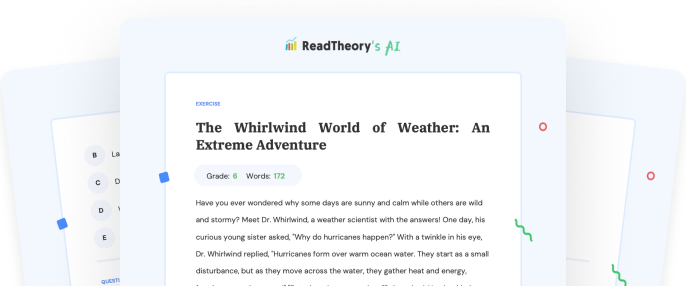Transform Your Teaching
with AI-Powered Worksheets
With ReadTheory’s Instant Worksheet Builder, you can create engaging, grade-appropriate worksheets tailored to your students in minutes. Spark curiosity, save time, and empower critical thinking with AI-powered tools designed for teachers like you.


Snowball Fights: A Fun, Frosty Tradition
It's a snowy morning. Excitement fills the air as children bundle up in their warmest clothes and rush outside. The battlefield is ready; it's time for a snowball fight! Ever wondered how these spheres of snow hold together? The answer lies in the snow's physical properties. As the snow is compressed in your hands, the pressure causes a slight melting, and the snowball takes shape. Did you know the world's biggest snowball fight took place in Saskatoon, Canada, in 2016? An astonishing 7,681 people participated! Imagine the flurry of snowballs! While snowball fights are heaps of fun, remember to follow some rules. Never use ice or pack snowballs too hard, as it can cause injuries. Wear appropriate protective clothing to keep warm and enjoy the game responsibly. What’s more? Apart from being a globally loved winter activity, a snowball fight can be a fantastic workout. It involves running, ducking, throwing, and laughing - a joyful cardio exercise that helps to warm you up in the frosty weather. So next time snow blankets your neighborhood, seize the opportunity for this fun, chilly adventure.
Question 1
What happens when snow is compressed in your hands while making a snowball?
It causes slight melting
It freezes instantly
It turns into ice
It evaporates
It becomes transparent
Question 2
Where did the world's biggest snowball fight take place?
Saskatoon, Canada
New York, USA
Oslo, Norway
Tokyo, Japan
Sydney, Australia
Question 3
What should you not use during a snowball fight to avoid injuries?
Ice
Snow
Gloves
Hat
Boots
Question 4
What physical activity does a snowball fight involve?
Running, ducking, throwing, and laughing
Swimming, diving, throwing, and laughing
Jumping, diving, catching, and laughing
Walking, ducking, catching, and laughing
Running, ducking, catching, and crying
Question 5
In addition to being a globally loved winter activity, what else is a snowball fight considered as?
A fantastic workout
A dangerous sport
An indoor game
A summer activity
A team sport
 or share via
or share via

Assign the ReadTheory pretest to determine students' reading levels.

Why Teachers Love
Instant Worksheet Builder?

Tailored Content for Every Student
Craft worksheets with passages and multiple-choice questions customized to your chosen topic and grade level, ensuring relevance and engagement.

Save Hours
of Prep Time
Our AI, Lexi, generates complete worksheets—passages, questions, and answers—in minutes, freeing you to focus on teaching, not planning.

Standards-Aligned Learning
Every worksheet is designed to boost reading comprehension and critical thinking, aligning seamlessly with State Standards to help your students shine.
Personalized teaching
for personalized learning
Browse worksheets created and refined by educators using Lexi—your source for inspiration and ready-to-use resources.


ReadTheory is free for Teachers to use.
Join thousands of educators using ReadTheory for free. Sign up today and start creating in just minutes!





